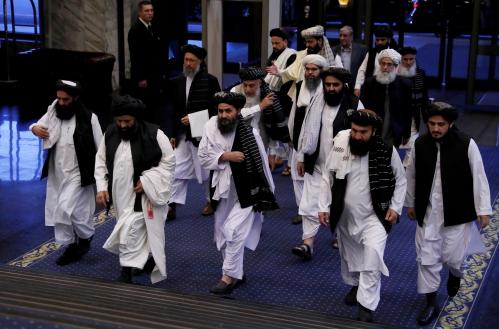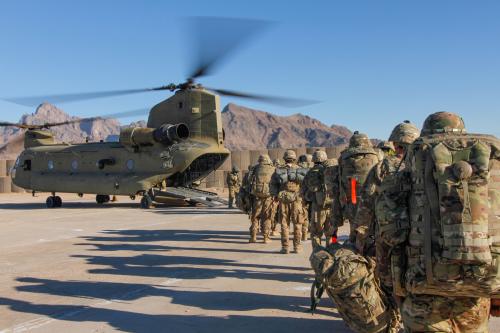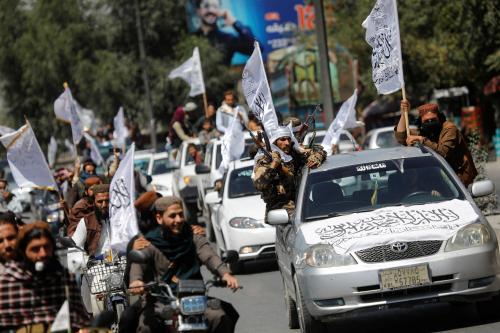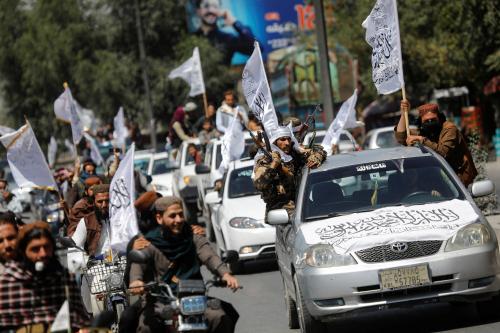The research reported here was funded in part by the Minerva Research Initiative (OUSD(R&E)) and the Army Research Office/Army Research Laboratory via grant #W911-NF-17-1-0569 to George Mason University. Any errors and opinions are not those of the Department of Defense and are attributable solely to the author(s).
The deal that the United States and the Taliban signed on Saturday allows the United States to extract itself from a stalled war. For years, the fighting showed no signs of battlefield breakthrough, while the United States held the Afghan security forces and Afghan government on life support.
Since at least 2015, U.S. policy has been one of wishing and hoping — hoping that the Taliban would commit enough strategic and technical blunders to do itself in. But the Taliban has not. The negotiated deal promises to secure basic U.S. counterterrorism interests and also provides a chance that peace will eventually come to Afghanistan — something Afghan people badly crave. Afghan security forces have lost perhaps as many as 50,000 fighters in the past five years, the Taliban perhaps the same number, and Afghan civilians have been dying at a rate of low thousands annually.
In fact, both peace negotiations and intense fighting can go on for a long time, long after U.S. troops have left Afghanistan. In a recent piece, I explored the divergent models of negotiations that various Afghan actors — such as the Afghan government and Taliban — and international partners have in mind for negotiations, and how these may unfold over the next several years. Here, I discuss some of the immediate issues over the next 14 months as U.S. troops are withdrawn from Afghanistan.
The deal itself
The basic parameters of the deal the United States and the Taliban signed have been known for almost a year. The United States has committed to withdraw its 12,800 forces from Afghanistan within 14 months, with the first 5,000 withdrawn in 135 days since the signing of the deal. The Taliban has promised not to conduct terrorist attacks against the United States or allow its territory to be used for that purpose. And the Taliban and the Afghan government have vowed not to militarily attack each other as U.S. troops withdraw. Meanwhile, within 12 days of deal being signed, the Taliban agreed to start engaging in a so-called intra-Afghan dialogue that will also include the Afghan government, and which will seek to arrive at a negotiated settlement among the Afghan parties. Those talks can take months, and more likely years.
To the extent that the announced deal contained any surprise at all, it was the speed of U.S. withdrawal: It has been estimated that the fastest possible timeframe for the U.S. military to leave, pack up and lift out its equipment, and dismantle its bases is actually 12 to 14 months. The Taliban had been asking for an unrealistic 6 months, but many analysts in Washington maintained that the speed of the negotiated withdrawal would be much slower.
The deal does not imply or guarantee that any intra-Afghan negotiated settlement will be signed before the U.S. withdraws its forces. Nor does it imply that the United States will slow or reverse its withdrawal if the talks are stuck and Afghan security forces are taking a pounding from the Taliban on the battlefield. Only a major terrorist attack against U.S. assets (such as the U.S. embassy or homeland) by the Taliban or a group linked to it — or from Taliban-controlled territories — would put the Taliban in breach of the deal and likely therefore halt or reverse the U.S. withdrawal.
Such direct breaches are unlikely. Nor will significant military pressure against Afghan security forces (which the Taliban probably will mount) necessarily be regarded as a violation of the accord. The U.S. military in Afghanistan declared Taliban attacks on Afghan security forces since Sunday a violation of the deal, or at least the non-published U.S. interpretation of the deal. And the U.S. military already responded with its first air attack against the Taliban to help Afghan security forces since the deal was signed. But how long will the response be maintained as the U.S. departs, as has already started happening?
Any hope that a permanent or lengthy ceasefire would be established before the start of an intra-Afghan dialogue died a long time ago. As soon as the seven-day violence reduction was over, the Taliban issued directives to its fighters to restart attacks on Afghan security forces. To some extent, battlefield commanders fear that their fighters could get too cozy with the barbershops and ice cream parlors that they could visit during an earlier ceasefire and then the seven-day violence reduction, making it hard to bring them back to the battlefield.
The Taliban’s broader strategy
At a more strategic level, the Taliban well understands that its battlefield performance will enhance its negotiating hand. Though hardly 10 feet tall, the Taliban has systematically managed to increase the battlefield operational tempo since 2015. U.S. airpower has limited its ability to take over provincial capitals and inflict even greater casualties to Afghan security forces. That counter will soon be removed as U.S. troop numbers go significantly down.
Still, the group may well hold off taking over a provincial capital and a province until spring 2021, when the U.S. military presence in the country has dropped dramatically and NATO and the other allies may also have removed many of their trainers and advisers. Till then, the Taliban is likely to mount the same type and perhaps even the tempo of military operations as it did in 2019, hitting Afghan security forces left and right and inducing units to sign local non-aggression pacts with the Taliban (a growing trend in 2019, as former Afghan defense and military officials told me during my fieldwork in Afghanistan in October 2019). Perhaps the biggest limitation on how much the Taliban heats up the battlefield is its need not to alienate the Afghan public too much, given the greater difficulty it will have in justifying violence against Afghan people once the U.S. troop presence has been substantially reduced.
It won’t be a small task for Taliban leadership to control the battlefield ambitions of its mid-level commanders. As the deal was signed, the Taliban had to engage in triangulated communication: Its spokesman gloated of victory (“the defeat of the arrogance of the White House in the face of the white turban”), clearly addressing mid-level battlefield commanders. But the Taliban’s negotiators in Doha issued a counterstatement, warning commanders against too much hubris and also seeking to reassure the United States. And the Taliban’s leader Haibatullah Akhundzada issued a peaches-and-cream statement to the Afghan people, promising peace, no revenge against those who fought the Taliban, and freedom and happiness under Islamic values.
Many young urban Afghans are not reassured, and fear the change in power distribution and political dispensation that negotiations with the Taliban are likely to produce. In contrast, in rural areas of Afghanistan, many Afghans want peace above all: They may have experienced little economic improvement and political and social freedoms over the past two decades. What they experience daily is the war and the loss of male breadwinners to fighting.
The Afghan government has long objected to the agreed parameters of the deal. In October 2019, it issued its own roadmap to negotiations, which was sensible but disconnected from the well-known U.S.-Taliban deal in the making. Hoping that the deal can yet be avoided, the government has not developed bargaining positions, such as redlines for which it will fight against the Taliban without the U.S. military around, perhaps for years to come. Even in late winter, it was still focused on composing its negotiating team while courting allies such as India, hoping it could derail the U.S.-Taliban deal.
The political tensions over the reelection of President Ashraf Ghani, contested by rival Abdullah Abdullah, have only compounded the lack of a unified negotiating front among Afghan politicians vis-à-vis the Taliban. Come December, when many fewer U.S. troops are around, it’s easily possible that the level of conversation between the Taliban and the Afghan counterparts is merely at the broad level of generalities.
It is not surprising that President Ghani has refused to release the 5,000 Taliban prisoners, something that the Taliban has long been asking for and expected after the signing of the U.S.-Taliban deal. The Afghan government understands that come winter 2020 and spring 2021, as the U.S. troop presence declines, holding at least some Taliban prisoners may be one of the government’s few precious levers in negotiations.
If, at that time, the intra-Afghan talks are stalled, pressures for a side deal between Afghan opposition politicians and the Taliban — perhaps seeking to overthrow the Ghani government and establish an interim one — will only grow. Rumblings to that effect have been bubbling in Afghanistan since fall 2019. If that happened, would the Afghan military hold or break up into ethnic factions? Would one of its powerful leaders attempt a military counter coup d’état? Would the United States continue to fund the Afghan security forces (without which Afghan forces would melt down), as it reiterated just this week? Those are some of the questions the Trump administration and its possible successor will need to grapple with.
Only under an extremely optimistic scenario would the intra-Afghan negotiations produce a reasonably stable settlement within 14 months. (Under much more auspicious circumstances, Colombia’s negotiations with the Fuerzas Armadas Revolucionarias de Colombia, or FARC, took four years; the Philippines’ talks with the Moro insurgents took 13 years and counting; Guatemala’s post-civil war peace accords took three years; and Nepal’s took over five years.)
What’s in store
However long the process takes and however much fighting occurs before that, the Taliban will likely continue to hold significant if not dominant power in Afghanistan. As Taliban-linked interlocutors told me, the Taliban wants to avoid a civil war and was very keen to avoid an “irresponsible” departure of U.S. forces — in other words, a departure without a deal with the Taliban, since the Taliban believes that would have pushed the country closer to a civil war and impeded intra-Afghan negotiations.
The Taliban maintains that once U.S. troops are out and it is in power, the group can have good relations with the United States and very much wants to maintain the flow of U.S. economic aid. Whatever power (and in whatever form) the Taliban has after the U.S. military departure, U.S. economic aid may ironically be one of the most important mechanisms to shape the Taliban’s behavior toward more inclusion, pluralism, and some respect for women’s and human rights.






Commentary
What’s in store after the US-Taliban deal
March 4, 2020